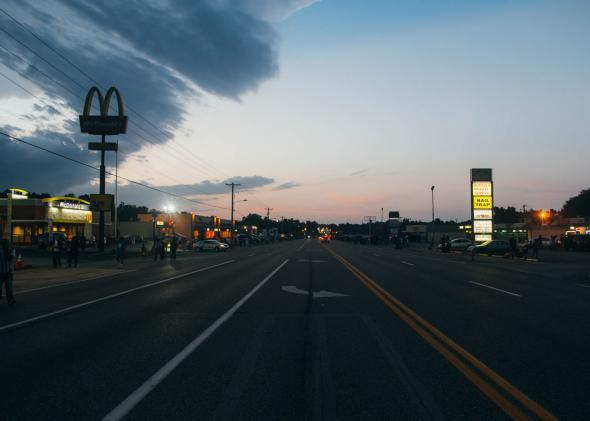FERGUSON, Mo.—“Marching, peacefully? I’m all for that. And sometimes it’s necessary,” says Robert Powell, while we stand in his garage, trying to escape the late summer heat. But, the older, longtime homeowner says, he wishes it were easier to get home past the police and the demonstrators. “I own a home. I pay my taxes. I have my rights. I should be able to get into my house.”
Powell might get his wish.
On Wednesday night, the Ferguson protests—centered on West Florissant Avenue—had shrunk from large demonstrations to a relative handful of marchers, circling the length of the area, which begins at the burned-out QuikTrip convenience store and ends at the now infamous McDonald’s. The air still carried slogans—“Hands up, don’t shoot! No justice, no peace!”—but they were quieter and less frequent than a few days earlier.
Likewise, there was still a pointed difference between daytime and nighttime protesters. During the days, the demonstrators are older and more likely to come from the surrounding neighborhoods. At night by contrast, the group skews younger, with teenagers, young adults, and a smattering of professional protesters and others from outside the community.

Photo by Jamelle Bouie/Slate
A growing proportion of people on the street—including myself—were media and law enforcement. Blue-uniformed police officers were stationed all around West Florissant, talking to demonstrators and reminding everyone to “keep moving”; the compromise for holding protests is that no one can congregate in a single area, a change that takes the energy out of demonstrators and precludes tension from building in groups. After a week of outrageous, disproportionate responses, police appear to have finally learned to create order without pointing weapons, using tear gas, or threatening mass arrests.
And indeed, when tensions eventually flared—sparked by a pro–Darren Wilson marcher who provoked a crowd of antagonized demonstrators around her—the police responded with proportional force. They cleared the street, dispersed the group—arresting one person in the process–and moved everyone to the sidewalks. Sudden rain made the job easier, sending everyone in a scramble for shelter and prompting the police to move back to their positions—no need for officers when marchers are moving of their own accord.
The story of Ferguson isn’t over. There’s still a lot of energy, and local activists hope to channel it into something durable and long-lasting. The Department of Justice is conducting its own investigation into Michael Brown’s killing, and Attorney General Eric Holder has told reporters that—even after media leaves—he intends to “continue the conversation this incident has sparked about the need for trust building between law enforcement officers and communities they serve.”
But if Wednesday night is any indication, the large mass protests of the last week are over. Even with unanswered questions and concerns, including the whereabouts of Wilson, it seems that—barring another unexpected provocation from the authorities that upends the peace—Ferguson is beginning to return to normalcy and everything that means.
On Tuesday—not far from where Brown was killed—police officers shot another young black man. The official report says they acted in self-defense. The man, 25-year-old Kajieme Powell, had allegedly taken food from a nearby convenience store, was “acting erratically,” and had brandished a knife, asking officers to “Shoot me now. Kill me now.” He stepped forward, and they fired.
A video—recorded by a witness—tells a slightly different story. Yes, the man was erratic, and yes, he had a knife. But police were quick on the trigger. Guns drawn, they leaped from their vehicle, barked a command—and before the man could respond—they shot. The body was handcuffed.
